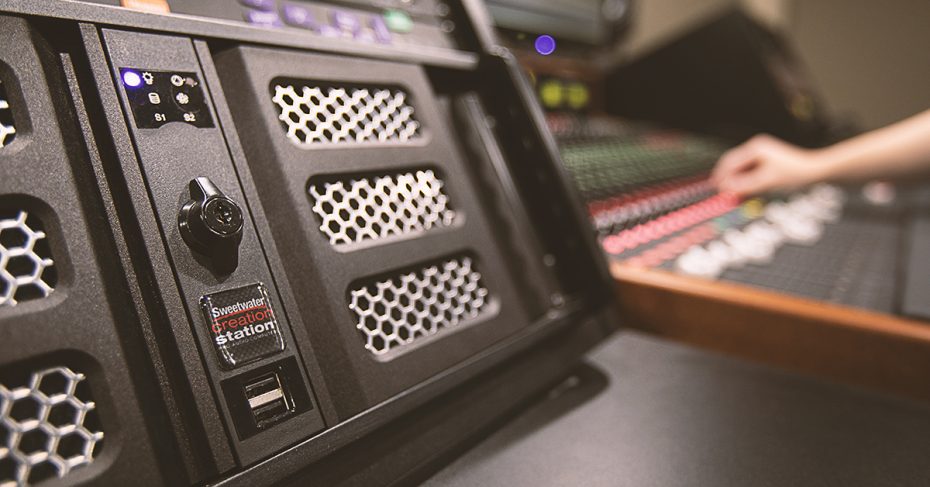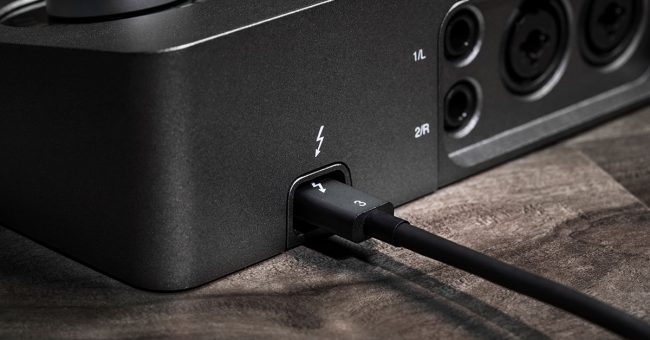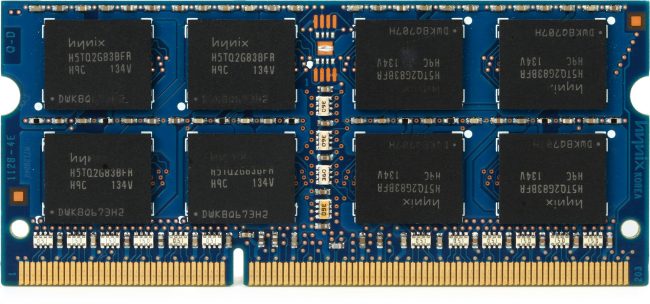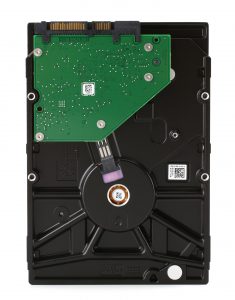
When you get serious about producing and recording your own music, the stability of your computer and operating system becomes crucial. If your computer struggles to achieve low-latency recording or buckles under a modest load of plug-ins and virtual instruments, then you’re going to find yourself out of your creative zone in a hurry. And that’s just when you’re working solo — technical issues while recording sessions for others can damage your reputation and, ultimately, your income. In other words, your choice of studio computer is one of the most important decisions you’ll make as a music producer. Read on to learn the best way to upgrade your studio computer.
Why Not Use Just Any Computer for Music Production?
It’s important to remember that, when you look at the published specs for just about any computer you can find, you’re not necessarily getting the full story on how well that machine will operate in a studio environment. Yes, processor speed, amount of RAM, number of USB ports, and other factors will be very important — but the bare numbers don’t give you the full story. Consider a couple basic facts about modern music production:
- You’ll likely be using lots of additional gear outside of your computer and DAW software, including an audio interface, control surfaces, keyboard and pad controllers, hard drives, and so on.
- You’ll want to make sure your basic needs for processor speed, RAM, and onboard storage are met, but you’ll likely want the option to expand them further in the future as your needs grow.
Regarding the first point, not all computer motherboards are created equal. Some computers may allow you to upgrade the processor in the future while others won’t. Some will allow you to upgrade your RAM in the future — others will not. Two different computers may offer Thunderbolt ports for high-speed, high-bandwidth connectivity, but it’s possible that only one of them will work reliably with your audio interface.
Looking at it from a development standpoint can help clarify the issue here — when an audio-device manufacturer like Avid, MOTU, Focusrite, or anyone else wants to make a product, they have to anticipate the types of systems you may be using and try to make their product as stable as possible on all platforms. And, with the prevalence of DIY computing as well as the huge range of low-budget computers on the market, it’s virtually impossible to anticipate every conceivable combination of motherboards, chipsets, and operating systems that end users could have.
In other words, it’s inevitable that many computers simply won’t play nice with your audio gear — even if the raw specs seem to add up to a powerful machine — simply because they use a certain combination of components. It could be fine for gaming or internet use but not for audio.
How Do I Check My Computer’s Specs?
To understand what you’re upgrading from, you need to know what your current computer’s specs are. Luckily, Sweetwater’s Technical Support experts have put together this handy guide to show you how to check the specs on your PC or Mac computer. Note that this can give you valuable info about the components of your computer beyond basic info like amount of storage and processor speed. You’ll also want to refer to this information on your new computer whenever you want to add new audio hardware or software.
Is Mac vs. PC Still a Thing?
Plenty of people seem to think so, but the reality is that you can create a reliable, pro-level recording and production system on either platform. It’s very important to understand a basic fact about Mac vs. PC — Apple is the only manufacturer that builds Mac computers, while any company (or you yourself) can build a Windows PC. Think back to our point on developing audio hardware for a specific platform: If a manufacturer develops an audio interface for use with Macs, there are only a handful of configurations they’ll have to anticipate — the type of motherboard, chipsets, and processors used are somewhat set in stone. If they want to develop for Windows computers, too, then they have a practically endless range of component combinations for which to try to stabilize and support that device. Since not all Windows PCs are created equal, it’s virtually impossible to provide rock-solid stability for every possible configuration.
That doesn’t mean one is inferior to the other — it simply means developing audio hardware and software for Mac is relatively simpler than for a Windows PC. If you’re using a low-budget Windows PC with components that aren’t supported by your audio interface or recording software, then you’re going to have issues. But if your Windows PC uses a motherboard, chipset, and other components that are supported by your interface and software, then you can enjoy the same stability as you would on a Mac.
These are just a few reasons why Sweetwater offers our line of Creation Station audio computers for Windows users. Creation Station computers are designed from the ground up for maximum performance with your audio gear and software. These PCs are tested, tuned, and optimized by Sweetwater audio experts to give you speed, power, and maximum system stability for music production.
What Thunderbolt 3 and USB-C Mean to Musicians and Engineers
Like all major changes, there are some initial issues as specs and gear settle into something new, but these advanced protocols already offer significant advantages.
What Specs Should You Be Looking For?
To help set a baseline for what your new computer’s specs should be, consider the recommended requirements for the DAW you plan to use. Consider these as minimum requirements — while the manufacturer may list their “minimum” requirements for the software, you’re unlikely to be able to use your software to its full potential with the minimum system specs. That being said, let’s take a look at the most accessible computer specs and shed some light on what to look for.
Processor
As the brain of your computer, your processor determines your system’s capabilities — how many virtual instruments you can run, how many tracks you’ll be able to have in your sessions, how quickly offline bouncing occurs, and so on. Considering this, most audio engineers would recommend getting the most powerful processor available for your chosen computer — don’t settle for the lower-powered processor to save a few hundred bucks if you’re serious about your production capability.
Can I upgrade my computer’s processor later?
If you’re going with a Windows PC, you may be able to upgrade the processor in the future if you decide you need more horsepower. With a Mac, you will not be able to upgrade the processor. If you get the fastest-possible processor available at the time, then you likely won’t need to consider a more powerful CPU for years, regardless of which platform you’re on.
RAM
No matter what you’re doing with your computer, the mantra has always been “the more RAM, the better.” RAM, or random-access memory, allows your computer to hold data for immediate access. More RAM means more audio tracks, more sample-based instruments, more simultaneous tasks, and faster overall system performance. While RAM is easier to upgrade than your CPU, it’s smart to add as much as possible right from the start. When shopping computers, you’ll often see the amount of RAM listed along with the maximum amount the computer will support. Again, referring to the recommended specs for your DAW software and audio interface will provide a good starting point for the amount of RAM you’ll need, but you’ll never regret maxing out your system right from the start.
Can I upgrade my computer’s RAM later?
It depends — you’ll want to confirm this for the specific computer you’re looking at before you commit to it. Most likely, you’ll be able to upgrade the RAM on any Windows PC that is suitable for music production. On the Mac side, some models support RAM upgrades by the user, some can be upgraded but only by Apple, and some models have soldered-in RAM and cannot be upgraded at all. In any case, it’s crucial to use RAM that is officially supported for your computer, even if you’re tempted by a budget-friendly generic alternative that “should” work.
Onboard storage — hard disk drive or solid-state?
Your computer’s hard disk drive or solid-state drive is where you’ll store your applications and system software. For music production, video editing, graphic design, or anything else media-related, it’s fairly standard to use external hard drives for your data (audio and video files, photo libraries, and so on) and also for system backups — and many media professionals will advise you that if your data isn’t backed up in at least two locations, it doesn’t really exist. All that is to say that your computer’s onboard storage is important, but you don’t necessarily need multiple terabytes of onboard storage — you should be using external drives for your media and for backups.
A much more important consideration for onboard storage, if given the choice, is whether to choose an old-school hard disk drive or a solid-state drive. Solid-state drives are much faster when it comes to accessing files — your system will boot up quicker, applications will launch faster, and file-management tasks will take less time. And, because solid-state drives have no moving parts, they’re more tolerant of bumps and drops than hard disk drives are. While hard disk drives are relatively less expensive and support larger drive capacities, most media professionals will agree that the performance benefits of solid-state drives leave hard disk drives in the dust.
Should I Get a Desktop Computer or a Laptop?
Unless you are setting up a mobile recording rig or want to be able to produce music anywhere at any time, you’ll definitely want to consider whether you really need the portability a laptop provides. As a general rule, a laptop is going to cost more than a desktop computer of comparable power and often will not offer as many ports or upgrade options. Many laptops will make fine music-production machines, but if your laptop ends up parked on the desk in your studio, then you’re not making the most out of it. If you’re not sure whether your music-production computer really needs the portability of a laptop, consider your budget and take a look at what a desktop computer would offer you in terms of power for the same price.
Invest in the Long-term
As the heart of your production studio, your choice of computer will affect your studio workflow for as long as you’re using it. As long as you anticipate all of your production needs and give yourself some room to grow in the future, there’s no reason you can’t enjoy many years of stable operation from your Mac or PC studio computer. Whatever you choose, a new computer for music production is a big investment, and Sweetwater is here to help — give your Sales Engineer a call at (800) 222-4700, and we’ll be happy to assist in narrowing down your options.





